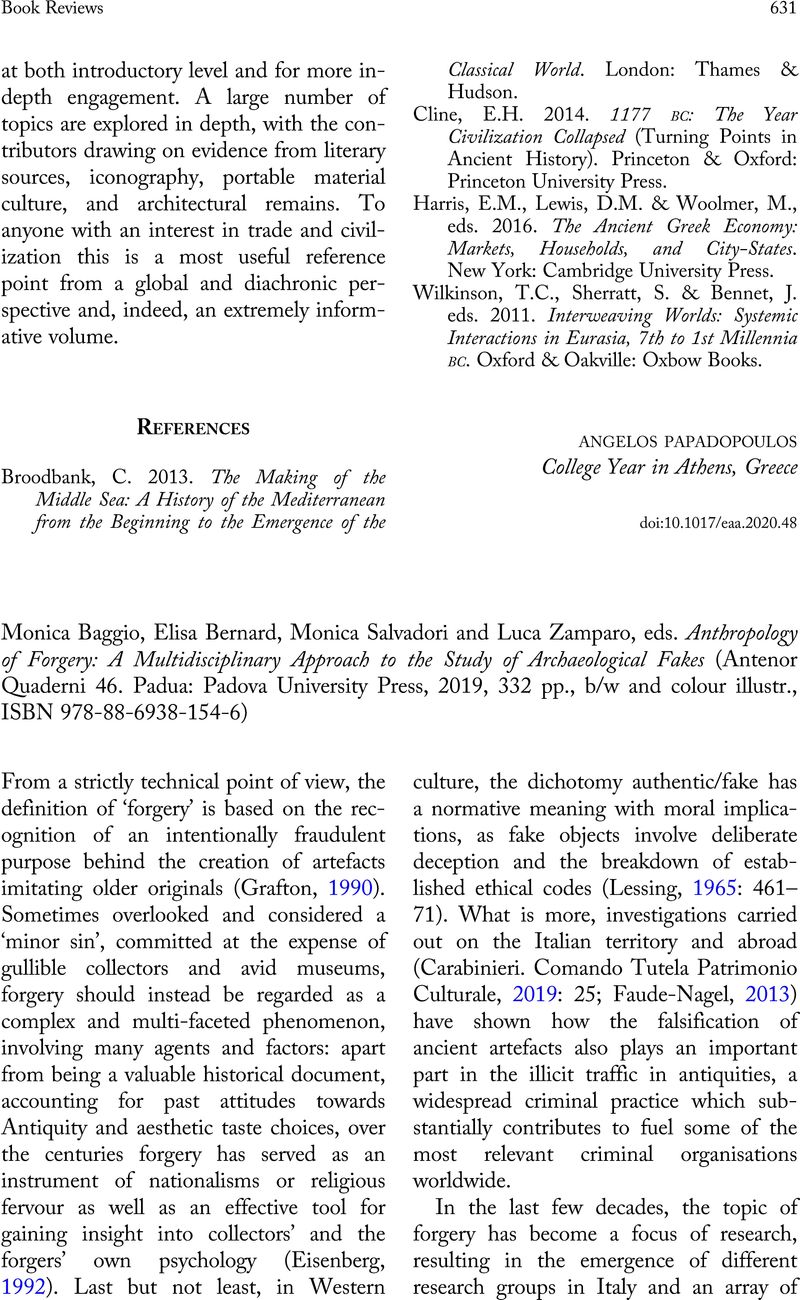No CrossRef data available.
Article contents
Monica Baggio, Elisa Bernard, Monica Salvadori and Luca Zamparo, eds. Anthropology of Forgery: A Multidisciplinary Approach to the Study of Archaeological Fakes (Antenor Quaderni 46. Padua: Padova University Press, 2019, 332 pp., b/w and colour illustr., ISBN 978-88-6938-154-6)
Published online by Cambridge University Press: 25 November 2020
Abstract
An abstract is not available for this content so a preview has been provided. Please use the Get access link above for information on how to access this content.

- Type
- Book Review
- Information
- Copyright
- Copyright © European Association of Archaeologists 2020
References
Bottini, A. 2016. Antico ad ogni costo. In: Zuchtriegel, G., ed. Possessione: Trafugamenti e falsi di antichità a Paestum. Napoli: Arte'm, pp. 47–50.Google Scholar
Carabinieri. Comando tutela patrimonio artistico, Ministero per i beni e le attività culturali & Università degli Studi Roma Tre 2018. L'arte non vera non può essere arte: Atti del ciclo di conferenze promosse dal Comando Carabinieri TPC, in collaborazione con il Consiglio Nazionale Anticontraffazione (CNAC-MiSE), il Ministero per i beni e le attività culturali e l'Università degli Studi Roma Tre, ottobre-dicembre 2017. Roma: Edizioni Efesto.Google Scholar
Carabinieri. Comando Tutela Patrimonio Culturale 2019. Attività operativa [Accessed 13.07.2020]. Available at: http://tpcweb.carabinieri.it/SitoPubblico/pubblicazioniGoogle Scholar
Eisenberg, J.M. 1992. The Aesthetics of the Forger: Stylistic Criteria in Ancient Art Forgery. Minerva, 3(3): 10–15.Google Scholar
Faude-Nagel, C. 2013. Kunstfälschung & Provenienzforschung am Beispiel von drei Fälschungen aus dem aktuellen Kunstmarkt. Mainz: Chorus.Google Scholar
Frieman, C. 2010. Imitation, Identity and, Communication: The Presence and Problems of Skeuomorphs in the Metal Ages. In: Eriksen, B.V., ed. Lithic Technology in Metal Using Societies. Højbjerg: Jutland Archaeological Society, pp. 33–44.Google Scholar
Grafton, A. 1990. Forgers and Critics: Creativity and Duplicity in Western Scholarship. London: Collins & Brown.Google Scholar
Jones, M. 1990. Introduction. In: Jones, M., Craddock, P. T., Barker, N. & Museum, British, eds. Fake? The Art of Deception. London: British Museum Publications, pp. 11–22.Google Scholar
Jones, M.; Craddock, P.T., Barker, N. & Museum, British, eds. 1990. Fake? The Art of Deception. London: British Museum Publications.Google Scholar
Lessing, A. 1965. What is wrong with a forgery? The Journal of Aesthetics and Art Criticism, 23(4): 461–71.CrossRefGoogle Scholar
Neuchâtel, S. & Kaeser, M. 2011. L’Âge du faux : L'authenticité en archéologie. Hauterive: Laténium.Google Scholar
Nagel, A. 2004. The Copy and Its Evil Twin: Thirteen Notes on Forgery. Brooklyn, NY: Immaterial Inc.Google Scholar




